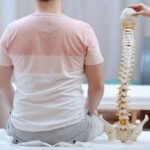Auto Injury Dizziness
Vertigo and dizziness are common after an auto injury. It can result from head injuries or a sudden, violent motion of the head that disturbs the vestibular system. Patients may also experience nausea, sleep disturbances, and balance problems, among other symptoms.
What is Cervicogenic Dizziness?
We borrow the definition of cervicogenic dizziness from Furman and Cassw: “a nonspecific sensation of altered orientation in space and dysequilibrium originating from an abnormal afferent activity from the neck.“. Cervical vertigo provokes a particular neck posture, no matter what the orientation of the head is to gravity. For example, dizziness caused by turning the head about the vertical axis, while sitting upright. Another definition is “vertigo due to neck disorders” (Ryan and Cope, 1955). We will use the symptom diagnosis, as we think that the implication of cause is unrealistic at present. Given our inability to diagnose cervical vertigo in general at the current writing.
People with cervicogenic dizziness because of auto injury tend to complain of dizziness. Which leads to worse during head movements or after maintaining one head position for a long time. The dizziness usually occurs after the neck pain and may be accompanied by a headache. Often the dizziness will decrease if the neck pain decreases. The symptoms of dizziness usually last minutes to hours.
People with auto injury cervicogenic dizziness may also complain of a general imbalance. This may increase with head movements and with movement in the environment. Although there are no completed formal studies yet, real cervicogenic dizziness is considerably rare.
Cervicogenic Dizziness Auto Injury Evaluations
An evaluation for auto injury cervicogenic dizziness involves a thorough medical evaluation. It is because the symptoms are similar to other causes of dizziness. The testing of inner ear function is usually present to ensure that the peripheral or central vestibular system is intact. A health care practitioner may perform a maneuver. They turn the body while the head is in the grasp to see if it has nystagmus (eye movements) or dizziness from auto injury to confirm the diagnosis. The results of this test need to correlate with subjective symptoms and clinical findings. This is because the test can also be positive in healthy individuals.
Cervicogenic dizziness often occurs as a result of whiplash or head injury. It is often in conjunction with brain injury or injury to the inner ear. It is difficult to distinguish between cervicogenic dizziness and other medical problems. Cervicogenic dizziness that occurs in conjunction with brain injury will be more challenging to diagnose and treat. It is essential to be patient while health care professionals sort through the problems and manage them in the most logical order.
Cervicogenic Dizziness After Auto Injury
During an auto injury, for example, the head can be forced traumatically forward and backward, causing what we call “Whiplash injury.” The body has a fantastic ability to keep your body up and prevent auto injury. Bracing for the accident in anticipation can cause more problems as the body, if braced, will tighten up. This tightening can cause severe tension, especially within the cervical spinal muscles. The patient may complain about sharp and or dull pain, un-easy gate walking on level ground, headaches, and limited range of motion in the neck. Cervicogenic dizziness is most often associated with flexion-extension injuries and observed in patients with severe cervical arthritis, herniated cervical disks, and head trauma.
It is common for patients to experience dizziness/vertigo after a motor vehicle accident. The injury sustained is typically viewed as a whiplash injury, but also affects the area of our brain that controls our balance, coordination, and spatial awareness. The regions of the neck at the base of the skull are extremely sensitive, and healthy feedback from these structures is required for understanding where our head should be in space. When this is damaged, so is the signaling that transmits information typically to our vestibular system, the part of the brain that controls our sense of balance and spatial awareness. If affected, it is common to experience lightheadedness, spatial awareness issues, dizziness, vertigo (a sensation which feels like either you or the room are spinning), and often migraines or headaches.
Common symptoms Cervicogenic Dizziness After Auto Injury:
- Difficulty focusing/concentration
- Dizziness/vertigo when looking from one target to the next
- Dizziness/vertigo at grocery stores/malls/department stores
- Migraines/Headaches
- Neck pain
- Dizziness/vertigo when turning your head, or turning over in bed
- Feelings of lightheadedness, spatial orientation unawareness
- A lapse in memory and slowness in thought
- Feeling as if the room is spinning, or the world around you is moving
- Feeling as if you are moving, often described as being on an elevator or looking over a cliff edge
Whiplash or Cervicogenic Dizziness Auto Injury is not only limited to a neck injury but also brainstem injury that does not involve direct damage to the neck or head. The symptoms of whiplash injury are polymorphous, with the most common complaints being cervical pain, headache, and scapulodynia. 25–50% of the cases also reported vertigo and dizziness. Otoneurologic studies used magnetic resonance angiography (MRA) to evaluate vertebrobasilar hemodynamics in patients who complain of dizziness and vertigo.
Other Common symptoms Cervicogenic Dizziness After Auto Injury:
Many things can cause dizziness and an imbalance of the equilibrium, so it is imperative that your primary caregiver correctly diagnoses what the cause is. With whiplash injuries, moderate to severe muscle spasms are very common, especially in the neck and upper back muscles.
Because the muscles are all connected by the connective fascia that surrounds and intertwines between the flesh, the muscles can form adhesions, lactic acid build-up, scar-tissue build-up, and trigger points. These can cause severe dysfunction within the tissue. When the flesh cannot function properly, the patients can experience a lack of range of motion, pain, and stiffness. These nasty trigger points and spasms can also be causing the dizziness due to the tightness and sense of unequal levelness.
Your chiropractor can help relieve Cervicogenic Dizziness Auto Injury
If you are having trouble with vertigo, your chiropractor may be able to help. In a recent report in Livestrong, an outline exists for chiropractic solutions. Chiropractic manipulation can help solve vertigo: “Your chiropractor will use manipulation targeting joints that are not moving properly. In the upper neck, faulty motion patterns create misinformation about body position and movement going from the joints to the brain. This type of vertigo, called cervicogenic vertigo, can be helped by chiropractic manipulation.”
Positioning Maneuvers: The inner ear houses the body’s exact balance center, the vestibulocochlear system. This complex system of fluid-filled tubes lined with hair-like sensors provides information to the central nervous system about position and movement. In some individuals, debris may accumulate there. If this debris settles on sensitive areas within the tubes, it may result in vertigo.
If the patient’s vertigo appears to be coming from the inner ear, a chiropractor may use the Epley Maneuver to reposition the debris to a more innocuous position.
Chiropractic Exercises to help Relieve Cervicogenic Dizziness Auto Injury
Your chiropractor will have exercises to help too. Therefore, activities like the Brandt-Daroff technique have the person sit on the edge of a bed and flop first to one side, back upright, then to the other at one-minute intervals. For instance, Tai chi exercise may also help as slow, and controlled movements provide a safe way to focus on your body movements and balance.
Your chiropractor will discuss your diet and daily habits to pinpoint other reasons for vertigo. Tobacco, alcohol, caffeine, and other substances that stimulate or depress the nervous system may become triggers. And non-prescription sleeping pills or antihistamines can spark dizziness. As a result, your chiropractor may also suggest meditation, relaxation, or breathing techniques to regain control. As you pursue diet, new daily habits, and relaxation techniques, be sure to discuss changes with your doctor to complete your health picture.
Chiropractic Relieves Cervicogenic Dizziness After Auto Injury: Scientific Research
In a study (Sajko SS, Stuber K, Welsh, 2013), eight patients with vertigo received chiropractic treatments aimed at restoring the function of the vestibular system. All patients reported a reduction in the duration, frequency, and severity of symptoms, including less pain and disability. After an average of eight days, every patient reported complete relief of vertigo dizziness. Furthermore, these improvements lasted for the follow-up visit three months later.
Moreover, other studies have shown that chiropractic can also relieve cervicogenic dizziness and headache. So if you’re suffering from dizziness after an auto injury, chiropractic could provide natural, effective relief.
Summary
In conclusion, chiropractic adjustments have helped many auto injury victims avoid invasive and risky surgeries, overuse of pain pills and injections, and years of residual discomfort from injuries that healed poorly. With safe, quick, and painless chiropractic adjustments and massage therapy, patients can rest assured that soft tissue injuries like whiplash will heal properly, enabling them to live pain-free and move past the physical and emotional trauma of the accident as quickly as possible.








